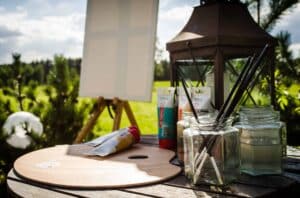
Welcome to the Yarnell School of Fine Art blog! Today, we’re diving into the vibrant world of acrylic painting, specifically focusing on the beauty of landscapes. Whether you’re a budding artist or a seasoned painter looking to explore new techniques, acrylics offer a versatile medium that can bring your visions of nature to life.
First, let’s talk about why acrylic paints are a fantastic choice for landscape painting. Acrylics dry quickly, allowing you to layer colors without waiting too long between applications. This quality makes them perfect for capturing the dynamic play of light in landscapes—think of how the sun dances on a serene lake or how shadows stretch across rolling hills.
Furthermore, acrylics can mimic both the translucence of watercolors and the richness of oil paints, giving you the flexibility to achieve a wide range of effects. Whether you prefer soft, blended edges or bold, defined strokes, acrylics can adapt to your style.
When it comes to choosing a landscape to paint, the possibilities are endless! You might be inspired by a local park, a majestic mountain range, or even a photograph from a recent trip. Start by selecting a scene that speaks to you. Take some time to observe the colors, shapes, and textures present in your chosen landscape. What draws your eye? Is it the way the light hits the trees or the dramatic colors of the sunset?
Once you’ve chosen your landscape, it’s time to prepare your canvas. A primed canvas or acrylic paper works well for this medium. Before starting, sketch a basic outline of your scene lightly with a pencil. This will serve as your roadmap, guiding you through the painting process while leaving room for creative adjustments.
Now, let’s get painting! One of the joys of acrylics is their layering capabilities. Start with a base layer, using a larger brush to cover the canvas with the sky or the ground. Don’t worry about precision at this stage; aim for a general sense of color and shape.
As your base layer dries, you can begin to add details. Use smaller brushes to define elements such as trees, mountains, or water. Remember, landscapes are about depth and perspective. To create a sense of distance, use lighter and less saturated colors for elements that are further away, and richer, darker hues for those in the foreground.
To truly capture the essence of your landscape, experiment with various techniques. For instance, use a palette knife to create texture in the rocks or trees, or try dry brushing to add highlights to the clouds. Don’t hesitate to layer different colors while the paint is still wet—this can create beautiful blends that mimic the natural world.
Once you’re satisfied with your painting, take a step back and assess your work. Are there areas that need more contrast or detail? Sometimes, adding just a few finishing touches can elevate your piece from good to great. Don’t forget to sign your artwork; it’s a proud moment that marks the completion of your creative journey!
We hope you’ve enjoyed this exploration of acrylic painting landscapes! We wholeheartedly believe that every artist has a unique vision waiting to be expressed. Whether you’re capturing the tranquility of a quiet forest or the drama of a stormy sky, acrylics can help you bring your imagination to life.
If you’re eager to learn more about acrylic techniques consider subscribing to Yarnell School Online and enjoy the vast array of instructional painting videos. Let’s create, inspire, and celebrate the beauty of nature together!
Happy painting!